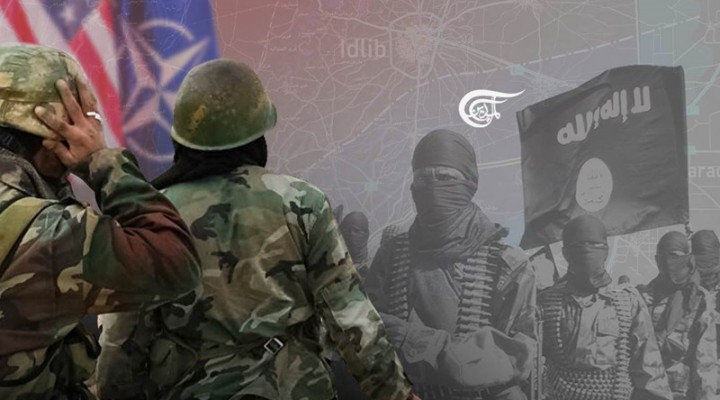Inside Syrian Idlib

For NATO, dismembering a country [Syria] is a second-best war aim, after the failure of complete ‘regime change’.
The NATO-embedded media often speaks as though the HTS/Nusra/al-Qaeda held enclave in two-thirds of Idlib Province represents Syria and is a haven of ‘moderate rebels’. They also claim the enclave holds 4 million people, while the Syrian government says 1.3 million.
War propaganda themes have become dutifully reported ‘facts’: this is a ‘Syrian Civil War’ (even as Syria is occupied by NATO’s two largest armies plus Israel, plus thousands of foreign terrorists), the Syrian Government has repeatedly used ‘chemical weapons’ (i.e. WMDs, meriting NATO retaliation) and (for some unexplained reason: pure evil?) bombs its own schools and hospitals.
But there is another Idlib: that part liberated, at great cost, by Syria’s national army.
From August 2019 through to early 2020, the Syrian Arab Army (SAA) liberated the south-eastern third of Idlib province, including the towns of Khan Shaykhoun, Maarat al-Numan, and Saraqeb. That opened the M5 highway for all traffic from the south to Aleppo, through Hama and SE Idlib.
The SAA looked for further advances, but the NATO powers demanded an end to Syrian operations, in defense of the al-Qaeda enclave. That real threat of intervention led Russia to engage in further talks with Turkey and to stall further advances.
Yet this development demonstrated that Syria, with its allies, could have freed the country from all terrorism were it not for repeated interventions from the NATO-led war coalition, which prefers to dismember and maintain occupied enclaves: NW Idlib, the NE ‘autonomous’ zone, the US occupied al Tanf zone and the Israeli occupied Golan.
In November 2021, I visited Syrian Idlib, authorized by the Syrian Army, just as most western journalists are authorized by US troops when they enter its various war zones. In one day, we traveled to Khan Sheykhoun in the south through Maarat al-Numan, the second-largest provincial city, to the strategic crossroads town of Saraqeb.
Khan Sheykhoun is the only Idlib town I saw with a significant civilian population. Mayor Mohammad Iskandar told us that 600 to 700 families have returned, about 10% of the pre-war population. Now far from the frontline, the town is peaceful with some rebuilding and small markets.
Most of those displaced moved to Turkey or north Idlib and some to other parts of Syria. The mayor is in touch with many and says most want to return, but the armed groups (HTS/Nusra) demand large sums of money for them to leave.
We also spoke with Mr. Iyad Sukheta, who runs a small grocery store, a small farm, and used to drive a bus. Like the Mayor, Iyad has also remained in Khan Sheykhoun throughout the conflict.
He says the ‘musalaheen’ (armed groups) took many prisoners and killed many local people, including his 17-year-old son. They wanted him to use his bus to drive people north, but he refused.
Asked about the chemical weapons incident of April 2017, Iyad said that the prisoners were not sacrificed (as they had been in East Ghouta in 2013) but rather, after a Syrian airstrike, the armed groups attacked the local people directly with chemicals. Many were killed.
Back in 2017, the armed groups blamed the SAA, using their own false flag massacre to incite President Trump (who had campaigned against the war) to make his first missile strike on Syria.
Maarat al-Numan is a much bigger town, with an ancient history and sitting on the frontline between Syrian forces and the Turkish-backed Nusra/HTS gangs. Even though the SAA has pushed its effective frontline forward three times in the past two years, there are no civilians here. The frontline, about 4km north, is constantly tested by the armed groups.
I visited Maarat’s museum with its famous Roman and Byzantine mosaics, which have been protected for several years with sandbags. As with many mosques, schools, and hospitals throughout Syria, the HTS/Nusra terrorists had used it as a military headquarters, digging tunnels under the Museum.
Jabal Zeitoun (Olive Mountain) is now at the center of the frontline, as it occupies the high ground from which the SAA’s 9th Division has placed a substantial vanguard of soldiers, tanks, arms, and surveillance equipment. Yet the actual Maarat frontline extends over many kilometers.
Nusra/HTS had built barricades around the town’s hospital and placed a small mosque inside. We saw evidence of supplies (medicines and cars) from Qatar, Germany, Sweden, and France. The typical pattern of the armed groups’ takeover of Syrian hospitals (for example in Aleppo) has been that they first rob all existing supplies.
Despite nominal support at the UN for the ‘territorial integrity’ of Syria, the NATO states had backed a breakaway Idlib enclave called ‘North Syria’. In much the same way, and contrary to international law, they still support an ‘Autonomous Administration of North and East Syria’. Dismembering a country is a second-best war aim, after the failure of complete ‘regime change’.
Further on up the road, the crossroads town of Saraqeb is also at the frontline, with Nusra/HTS making daily small arms attacks on, and occasional shelling of, SAA positions. They hide behind, and sometimes in front of, the many Turkish bases which are all across northern and central Idlib. The aim of these attacks, according to General J, has been to provoke retaliation which might spark direct conflict between Syrian and Turkish forces.
Captain Y took us to the frontline, looking out on the road to Ariha, and with a Turkish base 1.7 kilometers ahead. They know these distances quite precisely and are ready to liberate their country from foreign occupation and NATO-backed terrorism when the time is right.
Syria could have eliminated terrorism and restored its territorial integrity long ago, were it not for the NATO-led war coalition which prefers to fragment and occupy segments of the country, all along its land borders. In this way, they provide safe haven for internationally-proscribed terrorist groups.
https://english.almayadeen.net/articles/opinion/inside-syrian-idlib
 TheAltWorld
TheAltWorld 
0 thoughts on “Inside Syrian Idlib”